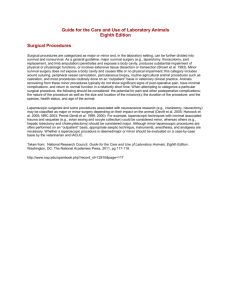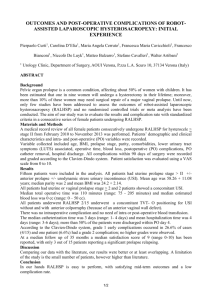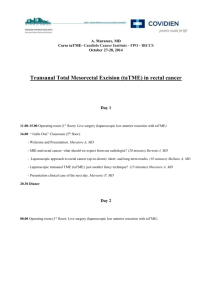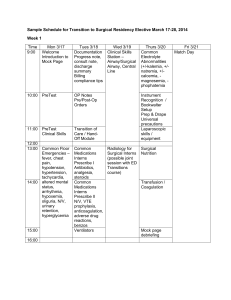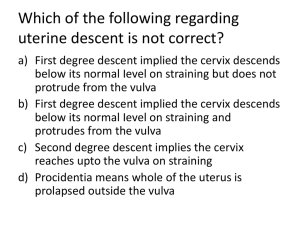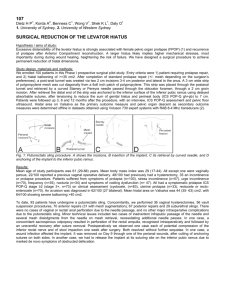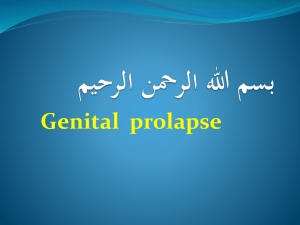208 a prospective randomized trial: abdominal vs laparoscopic
advertisement
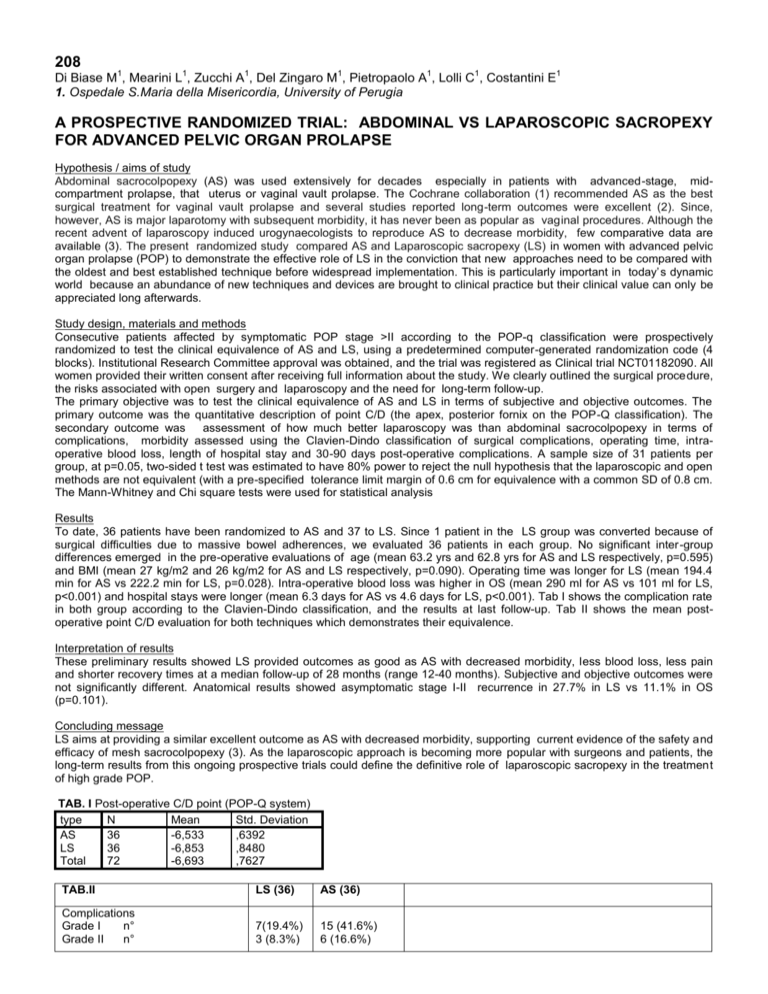
208 1 1 1 1 1 1 Di Biase M , Mearini L , Zucchi A , Del Zingaro M , Pietropaolo A , Lolli C , Costantini E 1. Ospedale S.Maria della Misericordia, University of Perugia 1 A PROSPECTIVE RANDOMIZED TRIAL: ABDOMINAL VS LAPAROSCOPIC SACROPEXY FOR ADVANCED PELVIC ORGAN PROLAPSE Hypothesis / aims of study Abdominal sacrocolpopexy (AS) was used extensively for decades especially in patients with advanced-stage, midcompartment prolapse, that uterus or vaginal vault prolapse. The Cochrane collaboration (1) recommended AS as the best surgical treatment for vaginal vault prolapse and several studies reported long-term outcomes were excellent (2). Since, however, AS is major laparotomy with subsequent morbidity, it has never been as popular as vaginal procedures. Although the recent advent of laparoscopy induced urogynaecologists to reproduce AS to decrease morbidity, few comparative data are available (3). The present randomized study compared AS and Laparoscopic sacropexy (LS) in women with advanced pelvic organ prolapse (POP) to demonstrate the effective role of LS in the conviction that new approaches need to be compared with the oldest and best established technique before widespread implementation. This is particularly important in today’s dynamic world because an abundance of new techniques and devices are brought to clinical practice but their clinical value can only be appreciated long afterwards. Study design, materials and methods Consecutive patients affected by symptomatic POP stage >II according to the POP-q classification were prospectively randomized to test the clinical equivalence of AS and LS, using a predetermined computer-generated randomization code (4 blocks). Institutional Research Committee approval was obtained, and the trial was registered as Clinical trial NCT01182090. All women provided their written consent after receiving full information about the study. We clearly outlined the surgical procedure, the risks associated with open surgery and laparoscopy and the need for long-term follow-up. The primary objective was to test the clinical equivalence of AS and LS in terms of subjective and objective outcomes. The primary outcome was the quantitative description of point C/D (the apex, posterior fornix on the POP-Q classification). The secondary outcome was assessment of how much better laparoscopy was than abdominal sacrocolpopexy in terms of complications, morbidity assessed using the Clavien-Dindo classification of surgical complications, operating time, intraoperative blood loss, length of hospital stay and 30-90 days post-operative complications. A sample size of 31 patients per group, at p=0.05, two-sided t test was estimated to have 80% power to reject the null hypothesis that the laparoscopic and open methods are not equivalent (with a pre-specified tolerance limit margin of 0.6 cm for equivalence with a common SD of 0.8 cm. The Mann-Whitney and Chi square tests were used for statistical analysis Results To date, 36 patients have been randomized to AS and 37 to LS. Since 1 patient in the LS group was converted because of surgical difficulties due to massive bowel adherences, we evaluated 36 patients in each group. No significant inter-group differences emerged in the pre-operative evaluations of age (mean 63.2 yrs and 62.8 yrs for AS and LS respectively, p=0.595) and BMI (mean 27 kg/m2 and 26 kg/m2 for AS and LS respectively, p=0.090). Operating time was longer for LS (mean 194.4 min for AS vs 222.2 min for LS, p=0.028). Intra-operative blood loss was higher in OS (mean 290 ml for AS vs 101 ml for LS, p<0.001) and hospital stays were longer (mean 6.3 days for AS vs 4.6 days for LS, p<0.001). Tab I shows the complication rate in both group according to the Clavien-Dindo classification, and the results at last follow-up. Tab II shows the mean postoperative point C/D evaluation for both techniques which demonstrates their equivalence. Interpretation of results These preliminary results showed LS provided outcomes as good as AS with decreased morbidity, less blood loss, less pain and shorter recovery times at a median follow-up of 28 months (range 12-40 months). Subjective and objective outcomes were not significantly different. Anatomical results showed asymptomatic stage I-II recurrence in 27.7% in LS vs 11.1% in OS (p=0.101). Concluding message LS aims at providing a similar excellent outcome as AS with decreased morbidity, supporting current evidence of the safety and efficacy of mesh sacrocolpopexy (3). As the laparoscopic approach is becoming more popular with surgeons and patients, the long-term results from this ongoing prospective trials could define the definitive role of laparoscopic sacropexy in the treatment of high grade POP. TAB. I Post-operative C/D point (POP-Q system) type N Mean Std. Deviation AS 36 -6,533 ,6392 LS 36 -6,853 ,8480 Total 72 -6,693 ,7627 TAB.II LS (36) AS (36) Complications Grade I n° Grade II n° 7(19.4%) 3 (8.3%) 15 (41.6%) 6 (16.6%) 30 days 90 days Last follow-up (mean, months) LS OS LS OS LS 27.3 months OS 29.6 months Constipation n°/% Pre-op 32 (16 LS -16-OS) 8 (22.2%) 6 (16.6%) 9 (25%) 4 (11.1%) 3 de novo 8 persistent 30.5% 6 de novo 3 persistent 25% Stress (s) / Mixed incontinence (m) Pre-op 22 (12 LS-10 OS) 4s / 2m 16.7% 8 s/ 1m 25% 5s/4m 25% 7s/3m 27.7% 7s /2 m 25% 2 to treat 7s/2 m 25% 5 to treat Storage symptoms n° 4 (11.1%) 1 (2.7%) 4 (11.1%) 1 (2.7%) 3 (8.3%) 1 (2.7%) 5 (13.8%) Urinary tract infection n° 5 (13.8%) 1 (2.7%) Port-site pain n° 1 (2.7%) 2 (5.5%) 1 (2.7%) 8 (22.2%) 2 (5.5%) 2 (5.5%) 2 (5.5%) Mesh erosion n° Recurrent Inguinal hernia n° Objective results Stage I-II cystocele Stage I-II rectocele 1 (2.7%) References 1. Maher C et al. Surgical management of pelvic organ prolapse in women. Cochrane Database Syst Rev (3): CD00401, 2007 2. Claerhout F, De Ridder D, Roovers JP, Rommens H, Spelzini F, Vandenbroucke V, Coremans G, Deprest J Medium term anatomic and functional results of laparoscopic sacrocolpopexy beyond the learning curve. Eur Urol 55:1459-1468, 2009 3. Freeman RM, Pantazis K, Thomson A, Frappell J, Bombieri L, Moran P, Slack M, Scott P, Waterfield M.A. A randomised controlled trial of abdominal versus laparoscopic sacrocolpopexy for the treatment of post-hysterectomy vaginal vault prolapse: LAS study. Int Urogynecol J. Mar;24(3):377-84, 2013 Disclosures Funding: None Clinical Trial: Yes Registration Number: Clinical trial GOV RCT: Yes Subjects: HUMAN Ethics Committee: University of Perugia Helsinki: Yes Informed Consent: Yes
